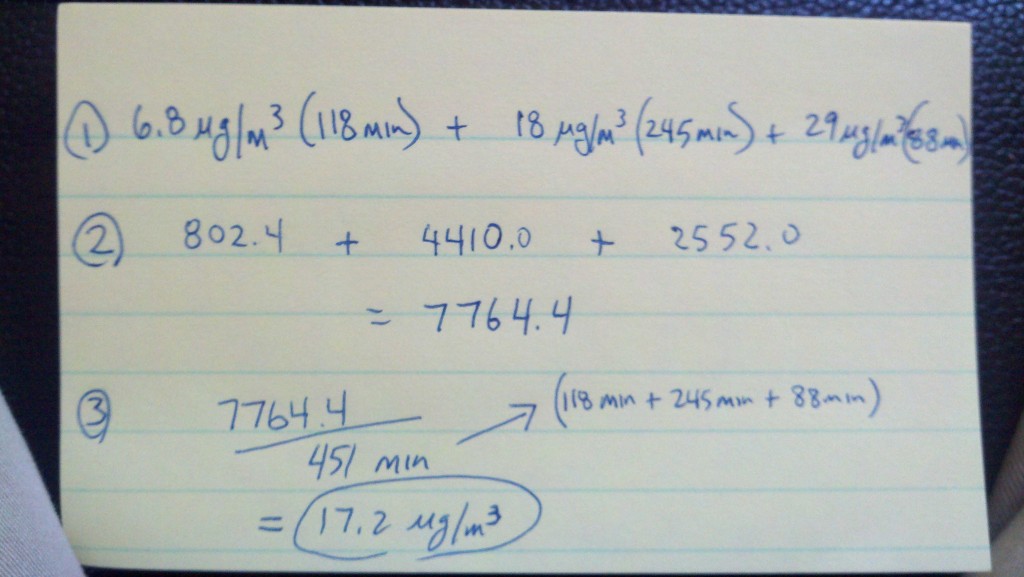Entries tagged with “TWA”.
Did you find what you wanted?
Thu 16 Aug 2012
Posted by admin under Air Monitoring, Cadmium, Concrete, Drywall, Dust, Exposure, Hexavalent chromium, industrial hygienist, Lead, Management, Mold, Silica, TWA, Welding
1 Comment
When performing air monitoring it can be useful to take multiple samples on the same individual throughout the day. Here are some reasons to change out the filters:
- build up of dust on filter – can cause overloading
- break-out the exposure data. Morning versus afternoon, or by job tasks, or the physical area the employee is working in, controls vs. no-controls, etc.
- if you question the employees motives. If you think the employee might skew the results, multiple samples might give you better control- or at least tell you if one is way-out-of-line.
Once you have your data results, how do you combine them?
If you’re taking particulate (dust, lead, cadmium, silica, etc) and you have the concentrations (from the lab) here is what to do.
- note the time (in minutes!) and the concentration results (mg/m3, ug/m3, etc) for each sample
- multiply the time and concentration for each – then add each number together
- finally, divide the above number by the total number of minutes sampled. This is your time weighted average (TWA).
Simple?! Yes. …And it’s really easy to make a mistake too. Check your math, and then eyeball the results and see if they make sense logically.
Here’s an example:
Andrew took three samples during one shift while Shelley was rivet busting through leaded paint. The first sample (118 minutes) was reported as 6.8 ug/m3 of lead, the second was for 245 minutes and had a concentration of 18 ug/m3. The last sample was taken for 88 minutes and was reported a level of 29 ug/m3. The overall results is 17.2 ug/m3 for the total time sampled. (Side: if you sampled for their entire exposure, and they worked longer hours, you could add those hours (assuming zero exposure) into the final time-in step three)
See the math below:

Wed 25 Jul 2012
As I have said in an earlier post, some OSHA, EPA, and MSHA rules are a good fit. They blend well with health research, scientific technology, good practices, and a low-cost-of-compliance for employers. Other rules are just bad. They are  totally out of date, not protective enough, or just not feasible/practical. Here’s my plug for a good safety manager/industrial hygienist – A good one will know which rules/guidelines to follow.
The New York Times (July 19, 2012, Cara Buckley) recently wrote an article on the US noise standards which are not protective enough for employees. In construction we also have three additional problems.
- hearing loss is expected (or at least assumed in certain fields – carpenters, sheetmetal, ironworkers, etc.) and,
- work shifts are usually over 8-hours. Noise exposure is usually calculated on an 8-hour time weighted average. During the busy months, an 8-hour work day is rare. It’s at least 10, maybe 12-14 hours. This doesn’t allow your ears to “rest” between shifts. For more information on extended work shifts go here.
- extracurricular activities contribute to overall hearing loss – my point is that most construction workers don’t sit at home at the end of their shift. Almost everyone I know in construction is involved in one of these activities: hunting, shooting, motorcycles, water sports, yard work, cars, wood working/cutting, concerts, music, etc. Each of these activities contribute to their overall hearing loss, and again, doesn’t allow your ears to “rest”.
…which reminds me that I need to keep a set of ear plugs in my motorcycle jacket.

Tags: ACGIH, dBA, dosimeters, EPA, hearing loss, IH, noise, OSHA, safety, sound, sound level, standards, TWA

